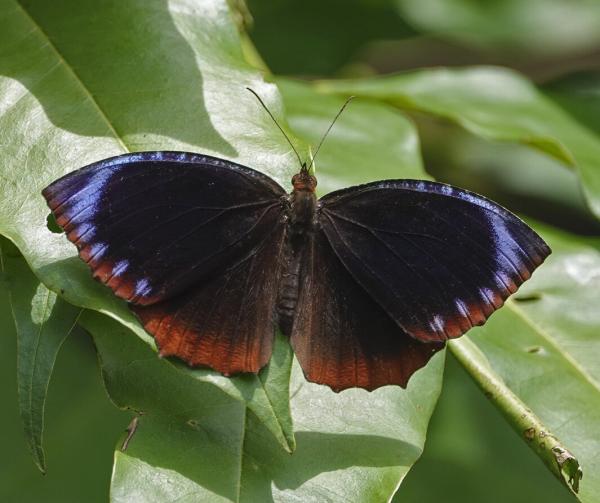
Photo of butterfly in the wild, Elymnias hypermnestra beatrice. Photo credit: Gan Cheong Weei.
Many animal and insect species use Batesian mimicry – mimicking a poisonous species – as a defense against predators. The common palmfly, Elymnias hypermnestra (a species of satyrine butterfly), which is found throughout wide areas of tropical and subtropical Asia, adds a twist to this evolutionary strategy: the females evolved two distinct forms, either orange or dark brown, imitating two separate poisonous model species, Danaus or Euploea. The males are uniformly brown. A population group is either entirely brown (both males and females) or mixed (brown males and orange females).
City College of New York entomologist David Lohman and his collaborators studied the genome of 45 samples representing 18 subspecies across Asia to determine their evolutionary history and to establish what genes were responsible for the color variation in females. They found that neither the orange nor brown females had a common recent ancestor.
“The conventional wisdom is that once something evolves and you lose it, it’s hard to re-evolve it,” said Lohman. “That suggests something is acting like a switch, switching the gene on or off.”
The researchers found two DNA nucleotides on the Elymnias hypermnestra genome that regulate WntA, a gene associated with color patterning in butterfly species.
The WntA gene can be switched on to recreate the phenotypic shift, even where it hasn’t appeared for several generations. Reaching back into genetic history allows a species to create a variant without having to re-evolve the intermediate biochemical pathways.
“Evolution of a phenotype can be more plastic than we thought,” said Shen-Horn Yen, one of Lohman’s collaborators from the Department of Biological Sciences, National Sun Yat-Sen University, Taiwan.
The study appears in the journal Proceedings of the Royal Society B.
To Lohman, studying Elymnias hypermnestra encapsulates the study of biodiversity in its entirety. There’s a universe of variety in color, form and size and genetic variability all found in a single genus of butterfly.
About the City College of New York
Since 1847, The City College of New York has provided a high-quality and affordable education to generations of New Yorkers in a wide variety of disciplines. CCNY embraces its position at the forefront of social change. It is ranked #1 by the Harvard-based Opportunity Insights out of 369 selective public colleges in the United States on the overall mobility index. This measure reflects both access and outcomes, representing the likelihood that a student at CCNY can move up two or more income quintiles. In addition, the Center for World University Rankings places CCNY in the top 1.8% of universities worldwide in terms of academic excellence. Labor analytics firm Emsi puts at $1.9 billion CCNY’s annual economic impact on the regional economy (5 boroughs and 5 adjacent counties) and quantifies the “for dollar” return on investment to students, taxpayers and society. At City College, more than 16,000 students pursue undergraduate and graduate degrees in eight schools and divisions, driven by significant funded research, creativity and scholarship. CCNY is as diverse, dynamic and visionary as New York City itself. View CCNY Media Kit.
Erica Rex
p: 845 668 0322
e:
erex@ccny.cuny.edu
View CCNY Media Kit.